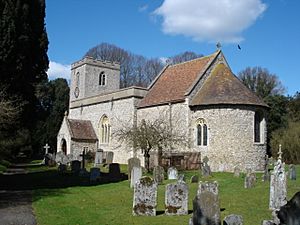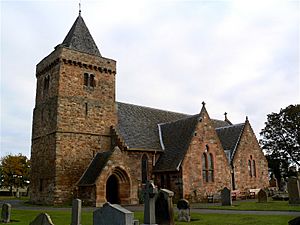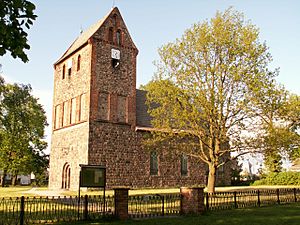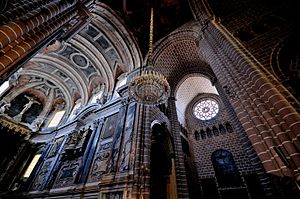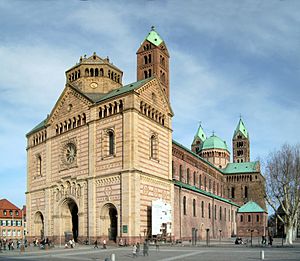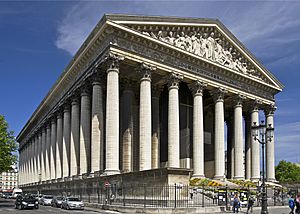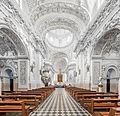Church (building) facts for kids

A church is a building where people meet to worship together. These people are usually Christians. Some other religious groups also use the word "church" for their worship buildings.
Churches come in many sizes, depending on how many people are in the community. Smaller churches are often called chapels. Churches in a certain area form a group called a diocese. Each diocese has a very large church called a cathedral. Cathedrals are important because they are where bishops have their main seat.
Contents
History of Church Buildings
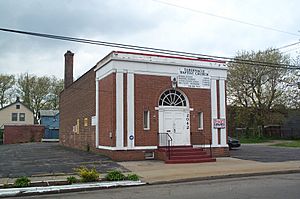
In the early days of Christianity, people had to worship in secret. This was because Christian worship was not allowed in the Roman Empire. So, Christians met in hidden places. Sometimes they used people’s houses or barns. They even met underground in small chapels carved into rock. This way, they could worship without being found.
After the Roman emperor Constantine died in 337 A.D., Christians were finally allowed to build their own worship places. The first churches were built like Roman basilicas. This design later inspired the beautiful Gothic cathedrals and churches built much later, at the end of the Middle Ages.
Parts of a Church Building
Churches have many different parts. Not every church will have all of these, but here are some common ones:
- The nave is the main area where the congregation (the people who come to worship) sit.
- The aisles are the walkways along the sides of the nave.
- The transept is a section that crosses the nave near the front of the church. This makes the church look like a cross from above. The cross is a symbol of Jesus's death on a cross.
- The chancel leads to the altar at the very front of the church. The altar is in the sanctuary. The word "sanctuary" means "sacred place." In the past, people could not be arrested in the sanctuary, so it was a safe place. The altar usually faces east. People in the church sit facing the altar.
- Most churches have a tower or steeple, often at the back (west end). If a church has a transept, the tower might be above the center of the transept.
In Roman Catholic churches, there is often a bowl of holy water called a stoup near the entrance. This tradition comes from Roman basilicas, which had a fountain for washing outside the entrance. The font is a large bowl where people (often babies) are baptized. It is also usually near the entrance, symbolizing a welcome into the Christian church.
Traditionally, the nave has long benches for people to sit on, called pews. Some modern churches now use chairs instead. This allows them to move the seating for different events. At the front of the nave is the pulpit. This is where the priest preaches (gives talks called "sermons"). There is also a lectern, which is like a tall music stand. This is where Bible readings are read aloud.
If there are aisles along the nave, there will be pillars that hold up the roof. In very large churches, there might be a row of small arches above these pillars. This is called the triforium. Above the triforium is the clerestory, which is a row of windows high up in the church wall.
The chancel is considered the most holy part of the church. It is often separated from the nave by a screen made of wood, stone, or iron. People can see through the screen. Sometimes, a cross is placed on top of the screen. This is called a rood screen. In the past, priests would climb stairs to the top of the rood screen to read parts of the Bible or for singing.
Inside the chancel are benches for the choir, called choir stalls. They are on both sides, with choir members facing each other. The side on the left (north) is called "cantoris" (where the cantor sits). The side on the right (south) is called "decani" (where the deacon sits). In some large churches, the seats for priests can tip up. The top of these tipped-up seats are called misericords. This name comes from the Latin word for "mercy." Priests or monks could lean on them when they got tired from standing for a long time.
Sometimes, there are holes in the walls of the screen called squints, allowing people to see through. If there is a small cupboard or recess in the wall, it is called an aumbry. This cupboard is used to store communion wine and bread that a priest has blessed.
The altar might be at the very end of the church. But in larger churches, it is often further forward. In that case, the very end part is called an apse. Sometimes, this area is a separate chapel, often called the "Lady Chapel."
Churches Through the Ages
The way churches were designed changed a lot throughout history. Often, churches were made bigger over time. This means you might see a mix of different building styles in one church. These styles also vary greatly from country to country.
English Churches
In England, churches were built in several different architectural periods:
- The Saxon period (700–1050) featured very simple churches. The end of the sanctuary was often rounded. Few of these churches remain today because most were made of wood.
- The Norman period (1050–1190) used a style called Romanesque, which was popular in Europe. The arches had decorative patterns called "mouldings." The tops of the pillars looked like cushions, so they were called "cushion capitals." Windows were narrow and rounded at the top.
- Early English or Gothic architecture (1190–1280) was lighter and less heavy than Norman architecture. Towers became elegant and tall, like the famous tower of Salisbury Cathedral.
- The Decorated style (1280–1360) was used during a time when the plague (Black Death) was widespread. A third of England's population died, so not much building happened then. Churches from this period often have many detailed stone carvings.
- The Perpendicular style (1360–1540) was very grand. It featured many straight, upward lines and beautiful fan vaulting. You can see examples in Westminster Abbey and King's College Chapel, Cambridge. Many churches still standing in England were built during this time.
In the 1600s, churches were built in various styles, sometimes copying older designs. After the Great Fire of London, many new churches were built by the architect Sir Christopher Wren. These were built in a classical style. This classical style continued to be used in later centuries, but the Gothic style also remained popular.
Modern churches often do not have the traditional cross-shape. This is because it can be hard for everyone to see and hear what is happening at the front. Modern designs aim to bring the congregation, choir, and priests closer together. An example is the round design of the Church of Christ the Cornerstone in Milton Keynes. Modern churches are often simpler but feel warmer than older Gothic churches. Many have beautiful mosaic glass windows. Coventry Cathedral is a famous example of a modern church building.
Related pages
Images for kids
-
Cyrican is an Old English word for churches and church property
-
The Frauenkirche in Munich is a largely Gothic, medieval church.
-
Las Lajas Shrine is a basilica church located in Colombia. The present temple, of Gothic Revival style, was built between 1916 and 1949
-
Central nave of the Church of St. Peter and St. Paul, Vilnius, Lithuania, an example of a Baroque church interior
-
The view of the spire of Norwich Cathedral from the cloisters, in Norfolk, England
-
St. Basil's Cathedral in Moscow, Russia (today a museum) is a famous and characteristic example of a Russian Orthodox Church building.
-
An interior of the Bridgettine's Nådendal Abbey, a medieval Catholic monastery in Naantali, Finland
-
Worship service at Christ's Commission Fellowship Pasig affiliated to the Christ's Commission Fellowship in 2014, in Pasig, Philippines
See also
 In Spanish: Iglesia (edificio) para niños
In Spanish: Iglesia (edificio) para niños


